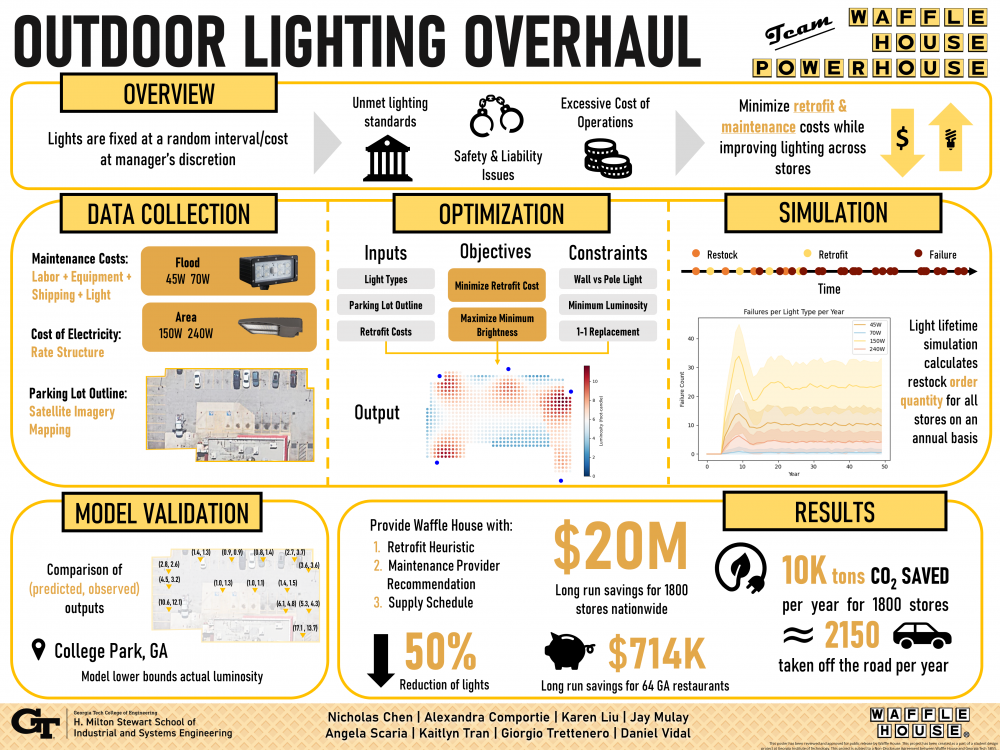Client Context
Waffle House (WH) is an American diner chain known for serving affordable breakfast items 24/7. Our client has identified a cost-savings opportunity by retrofitting their parking lot lights from high intensity discharge (HID) lights to light-emitting diode (LED) lights for approximately 1,800 locations. Under the existing system, lights are repaired at the individual restaurant manager’s discretion. The current maintenance system is inefficient and non-standardized which leads to inadequate outdoor lighting, which poses a safety hazard to customers and legal liability to WH, in addition to incurring excessive costs.
Project Objective
To address these problems associated with inadequate outdoor lighting, WH is currently negotiating a fixed price “Lighting as a Service” (LAAS) contract with a Regional Utility Provider (RUP) which includes retrofit and maintenance of parking lot lights for 64 pilot locations over the length of the contract. However, this contract is not ideal for several reasons. RUP would determine the type and number of lights to install which could result in excessive lighting costs. The client also does not maintain ownership rights over all equipment if they decide to terminate the contract in the future. A fixed contract period with a risk of price hikes in the future is also not an ideal situation for our client. We have identified opportunities to integrate WH’s internal maintenance team and independent contractors to solve our client’s lighting issues without having to sign the LAAS contract.
Design Strategy
To explore the most cost-effective way to meet the illumination requirement of individual parking lots, the team developed an optimization model. The team inputted geospatial data from satellite imagery on the layout of parking lots and their existing lights, and calculated the existing luminosity at any point given the different types of lighting fixtures, their angles, and the locations of the lights. The model was run on a subset of Waffle House locations with the objective of maximizing the brightness at all points in the parking lots, all while minimizing the long-run cost of retrofit to LEDs. Given that Waffle House requested a simple plan for retrofits that could be generalized to its wide variety of parking lots, the team found the most commonly occurring retrofit method for each type of light. For example, for a currently existing wall-mounted double light, the team’s recommendation is to replace it with a 70W LED wall-mounted single light. To evaluate the model’s accuracy, the team collected photometric data at a Waffle House that had recently completed a LED retrofit. We compared the observed luminosity values at multiple points throughout the parking lot to the model’s prediction, and concluded that our model’s outputs were well within range of the actual values.
Additionally, the client’s request for finding the best maintenance system was approached with simulations of both the retrofit system and the current system. They included the lifetime distribution of LED and HID lights to understand the mean lifetime of each of the bulbs, and when failures can be expected. Maintaining a lighting system also includes the procurement of the lights, and the reorder policy to maintain a proper inventory. The team simulated restock and retrofit events, using lifetimes randomly sampled from lifetime random variable distributions. The simulation, in conjunction with the aforementioned optimization model, calculates the present value distribution of maintaining retrofitted lights in perpetuity under three different maintenance provider options: the contract with the RUP, local independent providers on an as-need basis to individual restaurants, and the internal maintenance team. It also determines the restock schedule with order-up-to quantities on an annual basis. This ensures that all occurrences of lighting failures will be covered by the current inventory levels.
Deliverables
The project has three main deliverables. First, is a set of light replacement heuristics mapping existing HID light fixture types to new LED light fixture types. The heuristics are determined by an optimization model which takes in parking lot layouts mapped using satellite imagery of the 64 pilot locations and optimizes two objectives: minimize cost and maximize minimum luminosity. The second deliverable is a central warehouse restock policy ensuring lights will be available to restaurants chain-wide in the event of failures. The third deliverable is a cost comparison between maintaining the existing HID lighting infrastructure, signing RUP contract, and retrofitting the parking lots independently with maintenance provided by either an independent contractor, the WH internal maintenance team, or a hybrid of the two. The last two deliverables are outputs of a simulation which models a restock policy, retrofit schedule, and light failures across multiple stores in perpetuity. Our goal with the deliverables is to show how another solution aside from LAAS is financially superior, provide the client an optimal and feasible method of doing the retrofits themselves and provide the client with the data needed to have proper maintenance for the foreseeable future.
Value and Impact
The optimized lighting heuristic will allow WH to reduce their light count by 50% while satisfying lighting standards. For the 64 restaurants in Georgia, the team estimates present value long-run savings of $660K by utilizing the proposed hybrid maintenance option over the LAAS Contract. Projected to approximately 1,800 locations and assuming that similar rate contracts exist in other states, WH is expected to save $20 million in perpetuity over the fixed cost contract chainwide while meeting lighting standards. This savings is $18 million when compared to the current state. Our solution chainwide will also save 10,000 tons of carbon dioxide from being emitted annually. This is equivalent to approximately 2150 cars being taken off the road every year.


